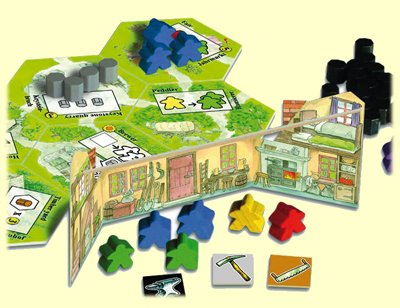
This is a very Euro design that uses meeples as your key currency. You need them to both bid on new tiles to add to your village, and to place on tiles in a worker placement-ish manner. There are four different colours (including the elusive green meeples), and one of the key factors in this game is that once a certain colour of meeple has been allocated to a tile - whether bidding or working - any further meeples sent to that tile have to be of the same colour. There's a real tension coming from this and you really have to get your priorities in order and carefully choose which meeples you send out.

The game takes place over four seasons, each featuring a different set of tiles that are auctioned off. The spring and summer tiles generate stuff - more meeples, more resources - which help you to get a little engine going. Autumn and Winter are where the victory points start racking up as start scoring big points for upgrading tiles, or stacking a certain kind of resource. The interesting thing about Winter is that you have some idea what's coming and can prepare for it. Each player receives a few Winter tiles right at the start of the game, which they keep hidden. Then when winter comes, rather than being randomly drawn as in the other seasons, the players choose at least 1 winter tile to put into the auction.
There's also a lot more interaction than you'd expect from this sort of game. Not only can the auctions get quite vicious, but you can actually use the tiles in other people's villages, with the drawback that they keep the worker meeples you sent there. But with some good timing - and especially if you have the dreaded green meeples - you can cut another player off from using their own stuff by sending a particular colour meeple their way, which can really mess up their plans. So you do have the ability to mess with the leader... although it's not always clear who that is! And given that everyone's meeple 'stocks' are kept hidden, you do have to keep a careful eye on what other people are doing to make a decent guess at what they've got left to work with.
At the end of each season a new shipment of worker meeples arrives on a set of boats (one per player). However these dwindle as the game goes on, so you need to spend the little guys wisely. Once winter's finished, everyone figures out their total VP and predictably whoever scored the most wins.

From my perspective there's a lot to love in this game. It moves at a decent pace, but has a good amount of meat on it. The tension as you start running out of meeples to spend and wondering if someone's going to outbid you at the last minute for that tile you NEED so badly. There's a decent amount of variety from game to game (though I'm considering expanding) and it supports 2-6 players. And it's pretty!
Thematically though, it doesn't really come through. There's some backstory about discovering this new land and building up a new community / civilization, but why don't the different colours work together? Are they horribly racist? And why does putting 10 wood on this tile make my village 30VP stronger than the village that didn't? This has never been a big deal to me - so long as the game looks nice on the table I'm happy - but I think Will for one felt like it was just a set of mechanics and couldn't get invested in it.
Still, I love it - 6 racist meeples out of 6 from me.
I liked it, and id certainly be happy to play it again, but i cant imagine this being one that i insist gets busted out at a gaming day.
ReplyDelete